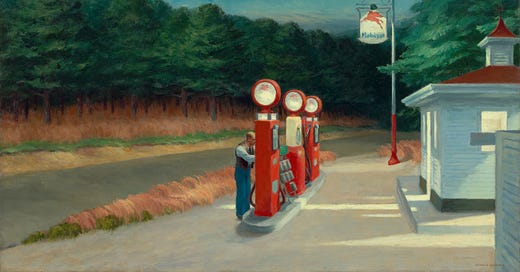Hoy he ido al MoMA. Me interesaba ver The Clock (2010), de Christian Marclay, un montaje de clips de películas y programas de televisión en los que aparecen relojes y referencias al tiempo, que se ajustan al tiempo real: “With each clip synchronized to the local time, The Clock collapses the fictional time presented on screen with the actual time of each passing minute. The work is both a cinematic tour-de-force and a functioning timepiece.” Así, cuando estaba allí las 11:55 am, en la pantalla decían: “Titanic leaves for America in five minutes!” Fascinante en muchos sentidos. Me hubiera podido quedar allí todo el día. Me hacía ilusión ver qué pasaría al mediodía y me sorprendió ver que alguien se salía a las 11:58 am, renunciando a ver la resolución de la tensión creciente en la pantalla.
Entré en tres ocasiones distintas y entre medias me iba paseando por las demás galerías. Además de ver las obras de arte, me gusta ver a la gente contemplándolas.



Una pareja italiana me pidió que les hiciera una foto recreando el beso frente al cuadro de René Magritte (The Lovers, 1928).
Porque no me lo esperaba me hizo ilusión ver Gas, de Edward Hopper, que era una de las imágenes que tenía guardadas para el blog, para cuando llegara el momento de poner un poema de Elizabeth Bishop que leí recientemente y que me gustó mucho (es de esos que ganan en algo con cada relectura, así que dadle un par de oportunidades). Será entonces la imagen y el poema de hoy.
También me cautivó especialmente la pintura de la mujer embarazada de Gustav Klimt. Para este año de la esperanza: Hope, II.
Cuando salí del museo e iba en bicicleta, vi un reloj en un edificio marcando la 1:25 y de repente me sentí en una escena de The Clock.
Estuve almorzando con A., a la que vi hace poco en Annapolis. Ahora está dedicada a la lectura de grandes libros, al mundo de las ideas, a pensar en qué es una imagen. Le pregunté por qué había dejado el mundo artístico de Nueva York, su trabajo en el MoMA (en el que paseaba como Pedro por su casa: ha tocado —movido— la Noche Estrellada de Van Gogh) y su propia producción artística. Me dijo que poco a poco se fue dando cuenta de la falta de ideas. O más bien, que aunque es un mundo con muchas ideas, casi siempre están a medio cuajar, que cada vez está más convencida que un artista también tiene que tener algo de filósofo y que necesitaban pensar y hacerlo a fondo. Y eso hace ahora, con seriedad y fascinación.
FILLING STATION
Elizabeth Bishop
Oh, but it is dirty!
—this little filling station,
oil-soaked, oil-permeated
to a disturbing, over-all
black translucency.
Be careful with that match!
Father wears a dirty,
oil-soaked monkey suit
that cuts him under the arms,
and several quick and saucy
and greasy sons assist him
(it’s a family filling station),
all quite thoroughly dirty.
Do they live in the station?
It has a cement porch
behind the pumps, and on it
a set of crushed and grease-
impregnated wickerwork;
on the wicker sofa
a dirty dog, quite comfy.
Some comic books provide
the only note of color—
of certain color. They lie
upon a big dim doily
draping a taboret
(part of the set), beside
a big hirsute begonia.
Why the extraneous plant?
Why the taboret?
Why, oh why, the doily?
(Embroidered in daisy stitch
with marguerites, I think,
and heavy with gray crochet.)
Somebody embroidered the doily.
Somebody waters the plant,
or oils it, maybe. Somebody
arranges the rows of cans
so that they softly say:
ESSO—SO—SO—SO
to high-strung automobiles.
Somebody loves us all.



